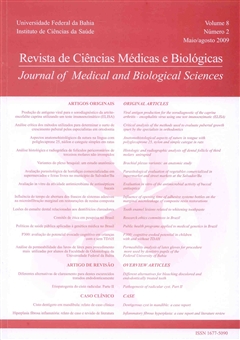Avaliação in vitro da atividade antimicrobiana de antissépticos bucais
DOI:
https://doi.org/10.9771/cmbio.v8i2.4065Palavras-chave:
Antissépticos bucais - Atividade antimicrobiana - Biofilme dental - Difusão em ágarResumo
O objetivo deste trabalho foi avaliar a atividade antimicrobiana de antissépticos bucais sobre Streptococcus mutans ATCC 25175, Pseudomonas aeruginosa ATCC 115442, Enterococcus faecalis, Staphylococcus aureus ATCC 6538 e sobre bactérias obtidas de uma amostra de saliva de 10 indivíduos. Foram analisados enxaguatórios com os seguintes antissépticos: gluconato de clorexidina a 0,12%; gluconato de clorexidina a 0,2 %; cloreto de cetilpiridínio com e sem flúor; timol; triclosan com flúor ; extrato de malva com flúor e xilitol e peróxido de hidrogênio. A técnica utilizada foi por difusão em ágar, método da placa com orifício, com incubação a 37º C em aerobiose e microaerofilia. Após incubação, observou-se a presença ou a ausência de halo de inibição de crescimento em torno dos orifícios. A formação de halo demonstrou atividade antimicrobiana. Nos enxaguatórios com timol e com flúor associado ao xilitol, não foi evidenciada atividade sobre as bactérias utilizadas. Os outros enxaguatórios apresentaram eficácia sobre as bactérias, com exceção dos que continham cloreto de cetilpiridínio, que não apresentaram atividade sobre Pseudomonas aeruginosa, e do enxaguatório com malva associada ao flúor e xilitol, sem atividade sobre P. aeruginosa, S. mutans e bactérias da saliva. Os enxaguatórios com triclosan com flúor, peróxido de hidrogênio e clorexidina foram os mais efetivos, de acordo com o diâmetro dos halos de inibição formados e a metodologia utilizada. Os resultados obtidos comprovaram que substâncias antissépticas podem constituir-se em opção complementar para o controle do biofilme dental e de infecções bucais, somando-se aos métodos já preconizados e de efeitos comprovados.Downloads
Não há dados estatísticos.
Downloads
Publicado
2009-06-02
Como Citar
Moreira, A. C. A., Pereira, M. H. Q., Porto, M. R., Rocha, L. A. P. da, Nascimento, B. C., & Andrade, P. M. (2009). Avaliação in vitro da atividade antimicrobiana de antissépticos bucais. Revista De Ciências Médicas E Biológicas, 8(2), 153–161. https://doi.org/10.9771/cmbio.v8i2.4065
Edição
Seção
Artigos originais
Licença
A Revista de Ciências Médicas e Biológicas reserva-se todos os direitos autorais dos trabalhos publicados, inclusive de tradução, permitindo, entretanto, a sua posterior reprodução como transcrição, com a devida citação de fonte. O periódico tem acesso livre e gratuito.






